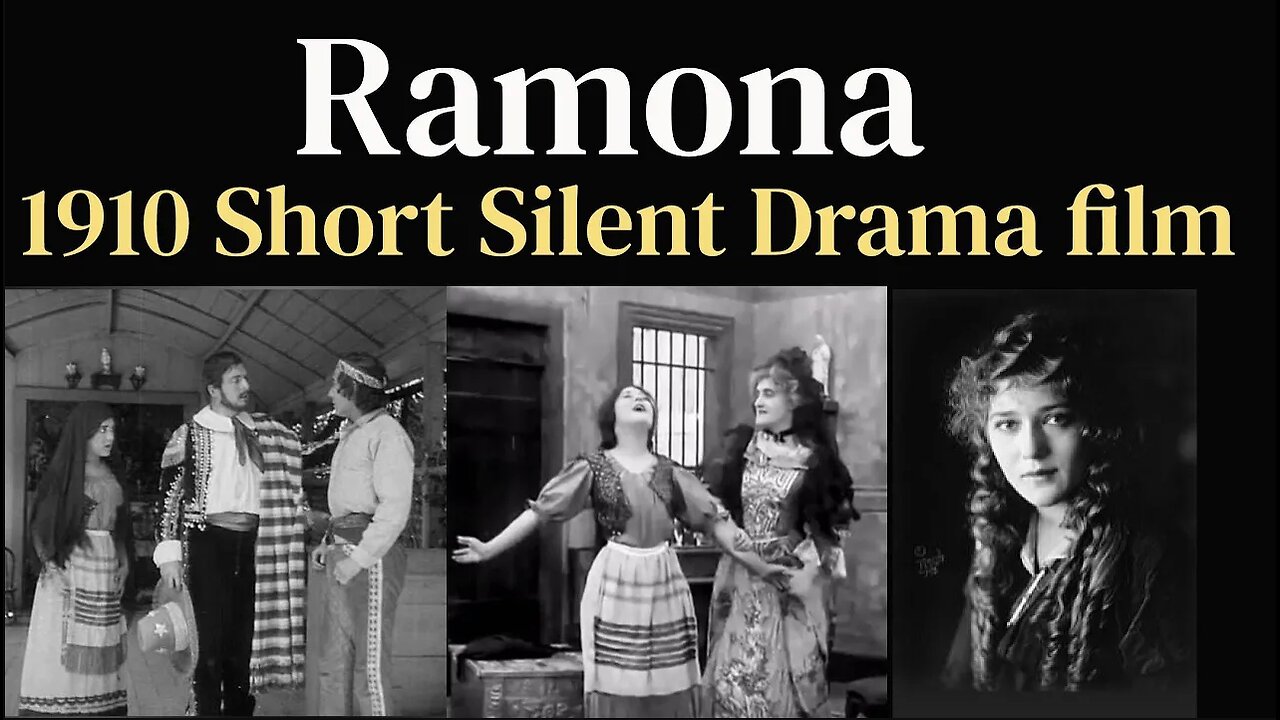Premium Only Content

Ramona (1910 Short Silent Drama film)
Directed by D. W. Griffith, based on Helen Hunt Jackson's 1884 novel Ramona. Through a love story, the early silent short explores racial injustice to Native Americans and stars Mary Pickford and Henry B. Walthall.[1] A copy of the print survives in the Library of Congress film archive. The film was remade in 1928 (dir. Edwin Carewe) with Dolores del Río and 1936 (dir. Henry King) with Loretta Young.
Plot
Ramona chronicles the romance between Ramona (Mary Pickford), a Spanish orphan from the prestigious Moreno family, and Alessandro (Henry B. Walthall), an Indian who appears on her family's ranch one day. Ramona's foster mother's son Felipe (Francis J. Grandon) proclaims his love for Ramona, but she rejects him because she has fallen for Alessandro. They fall deeply in love, yet their desire to wed is denied by Ramona's foster mother, who reacts by exiling Alessandro from her ranch.
Cast
Mary Pickford as Ramona
Henry B. Walthall as Alessandro
Francis J. Grandon as Felipe
Kate Bruce as The Mother
W. Chrystie Miller as The Priest
Dorothy Bernard
Gertrude Claire as Woman in west
Robert Harron
Dell Henderson as Man at burial
Mae Marsh
Frank Opperman as Ranch hand
Anthony O'Sullivan as Ranch hand
Jack Pickford as A boy
Mack Sennett as White exploiter
Production
Advertisements for the film emphasized that it was made "by arrangement with Little, Brown, & Company," the publishers of Jackson's novel. The film was shot on location in Ventura County, California, "at identical locations wherein Mrs. Jackson placed her characters."
When D.W. Griffith directed Ramona, the Biograph production company had fallen into hard times. Still based in New York to rival the now broken up Edison Company, Biograph needed a fresh face. Griffith joined the company in 1908 as a writer and actor. Soon, however, the head director of the company, Wallace McCutcheon, fell ill and his son had little success with taking over for him. This led Grifith to become the principal director for the company, and the only director for films made at Biograph between June 1908 and December 1909.
During these few months, Griffith turned out an exceptional number of films, with estimates of one 12 minute and one 16 long minute piece per week. The company actually began its venture out West to Hollywood thanks to Griffith's work on Ramona because he wanted to film on location in Ventura, California.
Longtime friend and colleague of Griffith's Billy Bitzer worked as the cinematographer for the film. Bitzer was hired originally as an electrician for the Biograph company, but his love of cameras pushed him to become one of cinema's most inventive pioneers. He experimented with photography, especially lighting and close-up shots. The Griffith and Bitzer duo formed shortly after Griffith directed his first film, The Adventures of Dollie and continued after both men left the Biograph production company in 1913. Bitzer's experimental nature is beautifully showcased in the film's sweeping landscape shots of the California mountains and distinct editing techniques like cross-cutting.
-
 32:55
32:55
The Connect: With Johnny Mitchell
1 day ago $3.40 earnedInside America's LARGEST Pot Trafficking Gang: How Florida Fishermen Became #1 Most Wanted Cartel
38.3K8 -
 2:05:15
2:05:15
Right Side Broadcasting Network
12 hours agoLIVE REPLAY: President Trump Attends UFC Fight 314 - 4/12/25
107K12 -
 2:07:42
2:07:42
BlackDiamondGunsandGear
10 hours agoWho’s in Town for This Stream?
57.7K4 -
 1:24:56
1:24:56
Quite Frankly
20 hours ago"Wild Tales: Crazy Story Hotline" | The Brothers Ep. 1
84.9K15 -
 12:37
12:37
Tundra Tactical
17 hours ago $6.07 earned🚫🚫 Biden Era GUN CONTROL Gone!!!! 🚫🚫
65.3K20 -
 1:00:09
1:00:09
Motherland Casino
9 hours ago $6.39 earnedCynthia X Mia
58.7K5 -
 5:32:47
5:32:47
BubbaSZN
16 hours ago🔴 LIVE - BUBBA PLAYS WARZONE SEASON 3
41.4K1 -
 2:29:26
2:29:26
Mally_Mouse
16 hours agoSaturday Shenanigans!! - Let's Play: REPO
58.4K14 -
 8:07
8:07
WhaddoYouMeme
1 day ago $5.02 earnedBut His Response Left Them Speechless!
44.4K55 -
 21:24
21:24
marcushouse
1 day ago $4.46 earnedStarship Launches Won’t Be the Same After This! 🔥
41.6K20